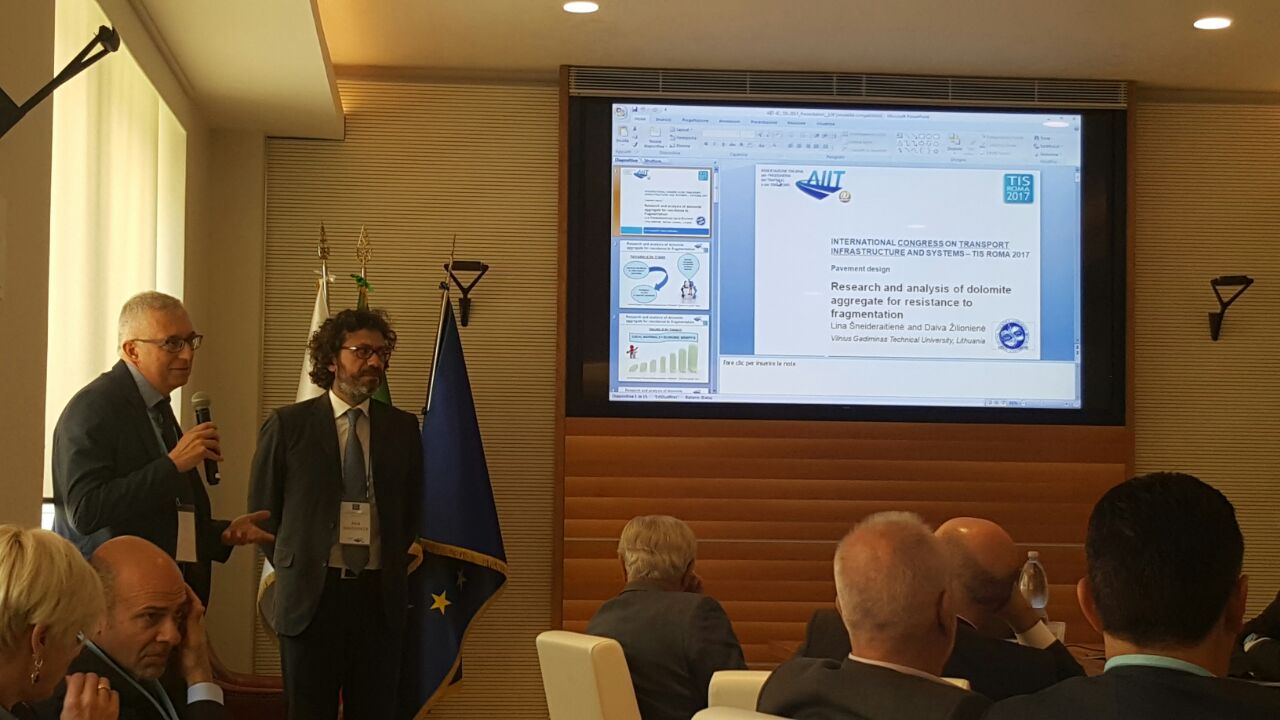TIS 2017
Session 17 – Pavement Design

Professor Ezio Santagata chaired the 17th session of the TIS Congress. The most innovative and low-impact technologies for road pavement construction were presented during this session. The pavement design applications presented were mostly focused on high performance products not only in the field of road construction but also in the field of pedestrian footpaths.
Vladan Ilić, Isidora Pančić, Marko Orešković and Dejan Gavran – The use of porous asphalt for the improvement of the grading plan geometry and drainage of pavement surfaces on urban roads / Porous asphalts are applied all over the world to minimize the effect of noise caused by everyday traffic. Beside the effect of noise reduction, thanks to their open texture and improved drainage characteristics, porous asphalts decrease the impact of spraying water behind a moving vehicle. Since drainage capability of porous asphalt as a surface permeable layer is much higher compared to a conventional dense-graded asphalt surface course, the values of cross grades of pavement wearing course on the road sections with porous asphalts should be additionally considered. Hence, the primary topic of the paper was how the application of porous asphalt could affect the geometric design of grading plans of pavement surface on urban roads, especially in intersection zones, where different longitudinal and cross grades of intersecting directions have to be mutually aligned. Due to a higher drainage capacity of porous asphalt layers, layout plan of storm water inlets can be changed if pavement cross grades are reduced.
Edoardo Bocci, Fabrizio Cardone and Andrea Grilli – Mix design and volumetric analysis of hot recycled bituminous mixtures using a bio-additive / Nowadays, the use of reclaimed asphalt (RA) as a constituent material for hot bituminous mixtures, is gaining increasing interest, because of the important technical and environmental advantages. One of these benefits deals with the reuse of the old bitumen from the RA, which allows reducing the required amount of new bitumen with clear economic returns. However, only a small percentage of RA can be recycled in new asphalt concretes (typically less than 20%), as the excess of oxidized aged bitumen may lead to a brittle behavior of the pavement layer. In order to avoid this issue, when high amount of RA are used, specific additives are recommended in order to restore the bitumen characteristics and thus obtain a mixture with the expected me-chanical properties. The paper presented deals with the use of a bio-based additive (A) for the production of an asphalt concrete for binder layer containing high quantities of RA. In particular, the study is focused on the mix design phase, in order to highlight the effects of RA and A on the volumetric properties of the mixtures. The experimental program included four asphalt concretes with no RA, 40% of RA, 40% of RA and additive A, 50% RA and additive A. Results showed that the optimum bitumen content decreased when decreasing RA content or when adding A. Moreover, the use of A allowed obtaining the desired volumetric properties even with a significantly lower amount of virgin bitumen in the mix.
Alibay Iskakbayev, Bagdat Teltayev and Cesare Rossi – Deformation And Strength Of Asphalt Concrete Under Static And Step Loadings / Asphalt concrete is one of the main materials for construction of pavement for modern highways. Its mechanical properties depend greatly on temperature, duration and type of loading. This work represents test results for samples of fine-grained asphalt concrete under static and step loadings during direct tension at the temperature of 20-24 °С. More than 100 samples of asphalt concrete have been tested. Bitumen of grade 100-130 was used for preparing of asphalt concrete. It has been determined that failure strain depends on type and duration of loading and does not exceed 10 %. Dependence of long term strength for asphalt concrete has been determined on the value of static load.
Federico Perrotta, Luis Canhoto Neves and Tony Parry – A Big Data approach to assess the Influence of Road Pavement Condition on Truck Fleet Fuel Consumption / In Europe, the road network is the most extensive and valuable infrastructure asset. In England, for example, its value has been estimated at around £344 billion and every year the government spends approximately £4 billion on highway maintenance (House of Commons, 2011). Fuel efficiency depends on a wide range of factors, including vehicle characteristics, road geometry, driving pattern, and pavement condition. The latter has been addressed, in the past, by many studies showing that a smoother pavement improves vehicle fuel efficiency. A recent study estimated that road roughness affect around 5% of fuel consumption (Zaabar & Chatti, 2010). However, previous studies were based on experiments using few instrumented vehicles, tested under controlled conditions (e.g. steady speed, no gradient etc.) on selected test sections. For this reason, the impact of pavement condition on vehicle fleet fuel economy, under real driving conditions, at network level still remains to be verified. A 2% improvement in fuel efficiency would mean that more than about 720 million litres of fuel (~£1 billion pounds) could be saved every year in the UK. It means that maintaining roads in better condition could lead to cost savings and reduction of greenhouse gas emissions. Modern trucks use many sensors, installed as standard, to measure data on a wide range of parameters including fuel consumption. This data is mostly used to inform fleet managers about maintenance and driver training requirements. In the present work, a ‘big data’ approach is used to estimate the impact of road surface conditions on truck fleet fuel economy for hundreds trucks along a motorway in England. Assessing the impact of pavement conditions on fuel consumption at truck fleet and road network level would be useful for road authorities, helping them prioritise maintenance and design decisions.
Lina ŠneideraitienĖ and Daiva ŽilionienĖ – Research and analysis of dolomite aggregate for resistance to fragmentation / Mechanical and physical properties of aggregates, used for producing asphalt mixture, influence the quality indices of pavement structure, i.e. functionality, reliability and durability. Investigation of various mechanical and physical properties of numerous aggregates by using test methods of EU standards Lithuania started in 2004. Requirements for resistance to fragmentation of aggregate, the technical specifications of mineral materials in Lithuania and in Latvia have been determined. The resistance to fragmentation of Lithuanian high quality dolomite aggregate meets Lithuanian and Latvian requirements according to TRA ASPHALT 08 Technical Specifications for Road Asphalt Mixtures and Ceļu SPECIFICATIONS 2015 for course mineral materials, bituminous mixtures and surface treatments.
CHAIRMAN: Ezio Santagata
The initial session program also included further presentations but for unpredictable reasons the speakers could not be present at the TIS congress.
Yang Yanqun, Huang Qinwei, Xu Meiling and Yu Sheng – Study on Paving factors of Stone Path in Campus Based on Characteristics of Pedestrian Walking / Stone path is usually seen in places such as campus, park, scenic spots, etc. Such road can not only serve as a passage, but also decorate and beautify the environment. The pavement of stone path is closely related to the characteristics of pedestrian walking. Therefore, it has been collected 306 valid samples by studying the stone paths and the characteristics of the students in a university, and analyse their





